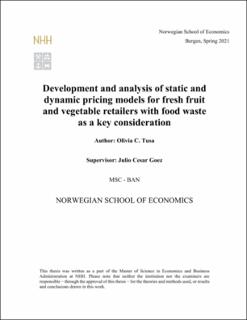Development and analysis of static and dynamic pricing models for fresh fruit and vegetable retailers with food waste as a key consideration
Master thesis
Permanent lenke
https://hdl.handle.net/11250/2786897Utgivelsesdato
2021Metadata
Vis full innførselSamlinger
- Master Thesis [4372]
Sammendrag
Fresh fruit and vegetable waste at retail locations is widely prevalent and often
accepted as a byproduct of food retailing. To recognize this source of food waste and
encourage change, the United Nations has introduced a goal to halve per capita food waste at
the retail level by 2030 (‘United Nations’, 2020). As retailers begin to turn their focus to an
all-encompassing triple bottom line, they have the opportunity to rethink their approach to
food waste. This research explores various retailer optimization methods to combat the food
waste of highly perishable items by utilizing the mathematical programming technique of
decision modelling. The models developed provide evidence that operating under a static
product pricing model with a singular objective to minimize waste is not a sustainable
approach for retailers as it neglects profits. Further, the inclusion of a financial weight on waste
in a profit maximizing business model with static pricing is presented as a more financially
effective approach. However, this model is also a likely unsustainable option due to the
modelled decrease in profits. Lastly, dynamic pricing by way of markdown management is
presented to offer food retailers a more sustainable method to sell fresh fruit and vegetables
with less waste. Of the four models presented, the Dynamic Pricing Model appears to be the
most applicable model for retailers and should be considered as an approach to reduce waste
among perishable items such as fresh fruits and vegetables.
